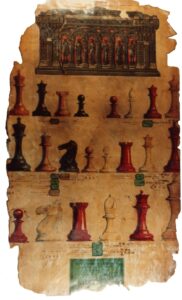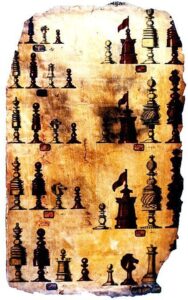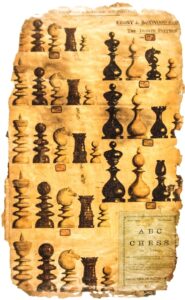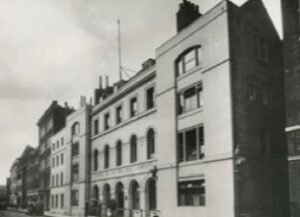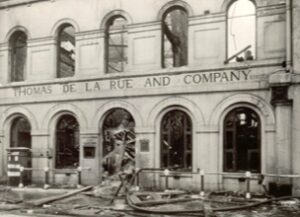In England, or better the British Islands, you find the most variety in types/patterns. They are sometimes called after a town or a famous maker or it’s workshop. This does not always mean that the set was actually made in that town or by that workshop. In many cases the type was made by others as well. Sometimes a reference is made to a famous person or a chess club.
John Calvert worked from 1791 until his death in 1822, after which his widow Dorothy took over until her death in 1840. He is one of the top chess set makers, well known of his beautiful Knights. His "CALVERT 189 FLEET STT" stamp may be found on sets (on Rooks) or boxes.
This very early set, in signed box, is historically interesting because the Knights are in the 18th century manner instead of the later carved Knights. The long thread that connects the head to the stem is also seldom seen. Normally, Knights in such sets are monoblock or connected with a pin.
It is almost certain that the wooden set has been made by Calvert, although it is not signed and came with a box in which St.George sets of presumably Jaques are seen. Most remarkable are the exceptionally well carved Knights, which are made of one piece of wood here. A feature seldom seen in wooden "St.George" type sets.
There exists a flower pattern which is called the "Calvert" type, which is made by many. See Jaques for an example.
- England, by Calvert
- 18th-19th century
- Ivory K 9.7; p 4.1
- Box 16.5×12.2×6.8
- Box signed "CALVERT 189 FLEET STT"
- England, by Calvert? "St.George"
- 1st half 19th century
- Boxwood + rosewood K 9.3; p 4.7
- Box presumably by Jaques 22.1×14.5×7.1
- Knights are made of one piece of wood!
George Merrifield is maybe the best turner of his time. His chess sets are outstanding in precision and beauty. As far as I know are all "Merrifield" sets actually made by George Merrifield and not by other manufacturers. George Merrifield worked from about 1819 till his dead in 1855.
- England, by George Merrifield
- Early to mid 19th century
- Ivory K 8.9; p 4.0
- Box 22.8×10.5×6.6
- England, by George Merrifield, "St.George" (pegged)
- Early to mid 19th century
- Ivory K 4.2; p 2.3
"Lund" type sets are called after chess sets made by father Thomas (at 56-57 Cornhill, London from 1804 until his death in 1843) and son William (at 24-25 Fleet Street, London from 1835 until his dead in 1872). We have seen signed sets of both. William took his father's running as well. His son Charles continued the business under the name of William Lund & Son. This type was very popular and has been made by several manufacturers. This particular set is larger, more chunky and has more discs on the pieces as usual.
- England, "Lund"
- Mid 19th century
- Ivory K 11,7; p 5.5
"Lund/Fisher" type chess sets are recognized by the open worked crowns of the King and Queen. Typically these sets are of large size. The box of this set is narrow and high, which could be the original box. Sorry, I have no picture of the box yet. The sets were most likely made in William Lund's workshop, although there are sets signed by Fisher. Fisher could have made these sets, but see also the section on Fisher itself.
- England, "Lund/Fisher"
- Mid 19th century
- Ivory K 12.5; p 4.9
- Box 23.9×10.9×15.9 (not pictured)
"Fisher" This travel set could very well have been made by Samuel Fisher. Collector Holger Langer describes a very similar set which is signed "Fisher" and "188 Strand". That's not a proof he made it, the sign could well have made on his demand. Samuel Fisher first shows up in the London directories in 1839 as a dressing case maker, and continued through at least 1899. From 1853 onwards he is listed with the address "188 & 189 Strand". In 1882 the listings changed to Fisher & Son. Although it is generally assumed that Fisher was solely a retailer, he is also listed as an Ivory Turner in the 1865 and 1869 trade directories.
- England, by Samuel Fisher? "St.George"
- Mid 19th century (sold as 1900)
- Bone K 3.3; p 1.6
- Box/board 15.3×7.7×2.8
(John) Jaques of London is probably the most successful maker. At least longest existing, from 1795 till the present day, and run by the 8th generation now. Most famous, of course, is the "Staunton" pattern, which was patented on March 1, 1849, by Nathaniel Cooke, 198 Strand, London.
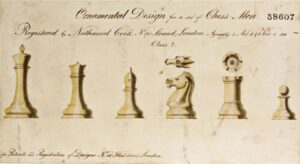
John and Nathaniel were related by the marriage of John's son John (II) with Nathaniel's daughter Harriet Ingram. Nathaniel was editor of "The Illustrated London News" (1842-2003), founded by his brother in law Herbert Ingram. That paper contained a chess column by Howard Staunton, who was asked by Cooke to advertise the chess set. He did so in his column on 8 September 1849 for the 1st time. As far as I know, Howard Staunton was the 1st sportsman to give his name to a product. It is not certain who is the designer of the Staunton pattern. It is not Staunton and probably also not Cooke. Most likely did John Jaques attribute to the design.
The codex of Frank Camaratta is an attempt to classify Jaques Staunton sets and the names "Anderssen" and "Broadbent" are from that codex and not names given by the Jaques of London company. The codex, however, is far from 100% decisive and Staunton connoisseur Alan Fersht did not use it in the 2nd version of his book. However, he is still using it at his website.
- England, by Jaques, "Staunton" ("late Anderssen")
- ca. 1870
- Boxwood + ebony K 7.4; p 3.7
- Box 16.0×11.6×6.8
- England, by Jaques, "Staunton" ("Broadbent")
- ca. 1935
- Boxwood + ebony K 9.7; p 5.3
- Box 21.8×16.8×10.8
Next to "Staunton", a lot of other chess set patterns is found in Jaques famous pattern book: "Barleycorn", "Calvert type", "Dublin", "Edinboro Upright", "St.George", etc. Jaques did invent and make a whole lot of other type of games as well. Below a few pages from their famous pattern book, what they are a bit mysterious about.
- England, by Jaques, "No. 24"
- Early to mid 19th century
- Bone K 13.6; p 4.9
- England, by (most likely) Jaques, "Calvert"
- ca. 1840
- Ivory K 8.4; p 3.9
- Box 16.5×12.4×8.0
Jaques made travel sets of the "Whittington" type in sizes of 6-8-10-12 inch. I have several Whittington sets, but none are signed. See Travel (England) page for Whittington type examples.
Jaques made these "In Statu Quo" chess sets in different forms. There exists also a larger version. This one is an early example, with places for captured pieces, which dates it from 1857 onwards. The pieces are ivory, which was an option I believe. By default they were made of bone. That this is an early set, around 1860, can be seen at the very thin pins that easily bend if you lock the pieces while not completely down. Maybe that is the reason that Jaques switched to pieces with significantly thicker pins. Also the holes in the board are smaller, because I noticed that pieces with the thicker pins don't fit well and only can be placed with brute force.
- England, by Jaques, "In Statu Quo"
- ca. 1860
- Ivory K 1.4; p 1.3 (without pins)
- Board 23.0×29.5×2.9 (open)
- Slipcase 15.9×23.9×7.2
F.H.Ayres. The business and factory of Frederick Henry Ayres, manufacturer, was started 1864 and from 1865 located at 10 Baldwin’s Place, Leather Lane, London EC, then from 1869 at 71 to 75 Red Lion Street, Clerkenwell and finally from 1877 at 111 Aldersgate Street, London, EC. It became F.H.Ayres Ltd. c1905 (known mainly for outdoor games). Later taken over by Slazenger (c1948).
F.H.Ayres made a range of different sets. Here some examples. Other F.H.Ayres examples can be found at “Barleycorn” and Slim-playing pages.
- England, by F.H.Ayres, "Dublin/St.George influenced"
- ca. 1900
- Tagua nut (vegatable ivory) K 8.6; p 4.3
- England, by F.H.Ayres, "Staunton"
- ca. 1930
- Catalin K 7.6; p 3.5
- Box 18.2×13.3×6.8
- England, by F.H.Ayres
- ca. 1930
- Plastic (Galalith?) 1.3 (1.9 with pin)
- Board 16.5×16.3×0.8
- Box signed "Ayres REG." 10.5×18.8×4.7
Asser & Sherwin, makers, 81 Strand, London. Grandfather Thomas Sherwin (1776-1863) was originally a bookbinder, but became a backgammon table and chess board manufacturer in about 1820. Father Thomas Sherwin (1802-1881) was also a dealer in games. Charles Sheppard Sherwin (1833-1872) formed in 1860 a partnership with his cousin James Asser (1836-1924) - 'Asser&Sherwin'. They traded until 1882 (despite the death of Charles Sherwin in 1872) at premises at 80-81 Strand and Oxford Street, selling travel goods, 'fancies', games and sporting equipment. Charles death certificate describes him as a Bagatelle Board Maker. On the closure of the company James Asser went on to found Turnbull and Asser the Jermyn Street shirtmakers. Recently (Sep. 2020) I found a lid of a box with their logo. I have only the lid and no box. Also don't know what was in the box originally.
- ASSER&SHERWIN
- MAKERS
- 81 STRAND.LONDON
Thomas De La Rue 1st commercial venture was a newspaper on Guersney in 1813, but moved the printing business to London in 1821. In 1831 the company started to make playing cards, a division sold to John Waddington in 1969! In 1855 it started to print postage stamps and in 1860 banknotes (for Mauritius). In 1874 they opened a new factory in Bunhill Row, London. In 1881 they entered the pen market. In 1898 the family partnership structure changed to a private company and the De La Rue family left the business and the company became publicly owned. Today their main business is currency and authentication. On De La Rue site is a lot more of information.
De La RUE factory at Bunhill Row opened in 1874 and demolished on September 11th 1940
The name on the building is: "THOMAS DE LA RUE AND COMPANY". Pictures are unclear, but 2nd one seems to show a small "Limited". I could not find out if "Limited" was added in the period between the 2 pictures or was there from the beginning.
Of interest to us are their Wallet sets and Stud sets. Such stud set has a clamp which can have different inscriptions: "TDLR", "TdLR" or "DLRLd". "Thomas De La Rue" or "De La Rue Limited", I think. In 1958 the company dropped Thomas in their name. Question is whether these sets could have been made after 1958 as well ? I have been told that's not the case.
De La Rue wallet set and stud set.
The origins of B&Co. are unclear and research didn't reveal much. What can be determined, based on the style of the chessmen and their boxes is that B&Co. started producing Staunton chessmen in the mid to late 1850s. Stampings are found on their extremely scarce, but beautiful, "Regulation Chessmen" which come in signed box. Specific is that bases are made separately and are screwed. We see that on ivory and bone sets, but rarely on wooden "Staunton" sets. Note the King without cross. B&Co. sets are rare.
- England, by B&Co. London, "Staunton"
- Mid to late 19th century
- Boxwood + ebony K 7.4; p 4.0
There are a lot of other makers or retailers, like Asprey, J.Barr, BCC (founded by W. Moffat and W. Hughes, making chessmen from 1891 to about 1907, well known by the use of Xylonite, a celluloid), H.Dixon, W.Hallet, C.Hastilow, W.Howard, W.Leuchars (probably the 1st retailer of Jaques Staunton sets), Wedgwood, R.Whitty, to name a few older ones. I do not have examples of all of these makers/retailers, but you can find some of them elsewhere on my site.
Here some "Staunton" sets of unknown makers. The large 41/3" (11.1cm) ivory set is a beautiful set, but it's origin is unclear. Someone has crudely marked or re-marked the crowns and Jaques signature. Frank Camaratta, at Oxford CCI meeting in 2024, closely looked at the pictures but wasn't sure. Frank could only tell for sure if he saw the pieces itself, which could only done at my home because I cannot take them abroad. On the other hand, Jaques made ivory sets in this size where Rooks are a bit taller than Knights, as is in this set. Unfortunately does one white Knight miss a little piece of its jaw. The box is not a chess box, I think, and is not in best condition. The 32/3" (9.3cm) bone set is extremely scarce. It is very much rarer as wooden ones, and even more rare as the ivory ones, especially in this size which is large for a bone set. Beautiful Knights as well. I think the box it came in is original. The 21/2" (6.5cm) small wooden set is also of an unknown maker, but is not that uncommon. Note the King without cross.
- England, by Jaques? "Staunton"
- Mid to late 19th century
- Ivory K 11.1; p 4.7
- Box pp.p×qq.q×r.r
- England, "Staunton"
- Mid to late 19th century
- Bone K 9.3; p 4.3
- Original box 15.9×11.2×8.0
- England, "Staunton"
- Late 19th century
- Boxwood + ebony K 6.5; p 3.5
20th century makers Mildred Rose and Britain made lead sets based on the "Staunton" design. You find them on "The Rose Chess" and Britain pages. A set from K&C Ltd. in London is not in the collection. On the Plastic page more "Staunton" sets of manufacturers like Grays of Cambridge, Chad Valley and House Martin. Some of unknown makers as well. On the latter page is a very rare plastic travel set by F.H.Ayres as well (see also Travel (England)).
